Organizational Behavior and Management Studies
VerifiedAdded on 2020/10/04
|15
|4731
|369
AI Summary
This assignment provides an overview of various research papers related to organizational behavior, including studies on participative leadership, emotional intelligence, and negotiation strategies. It also touches upon topics such as presenteeism in the workplace, general vs specific measures in organizational behavior research, and determinants of organizational citizenship behavior.
Contribute Materials
Your contribution can guide someone’s learning journey. Share your
documents today.
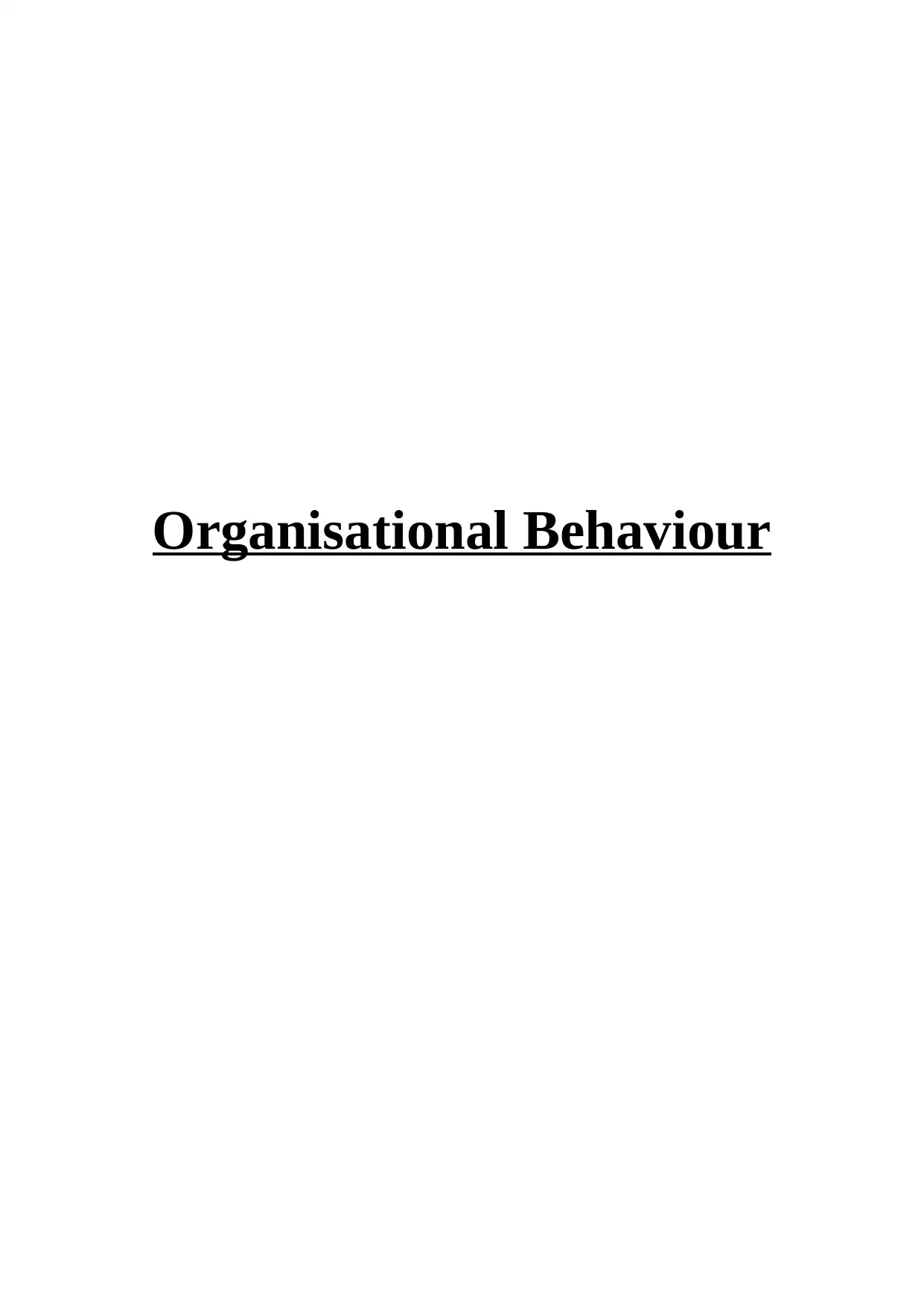
Organisational Behaviour
Secure Best Marks with AI Grader
Need help grading? Try our AI Grader for instant feedback on your assignments.
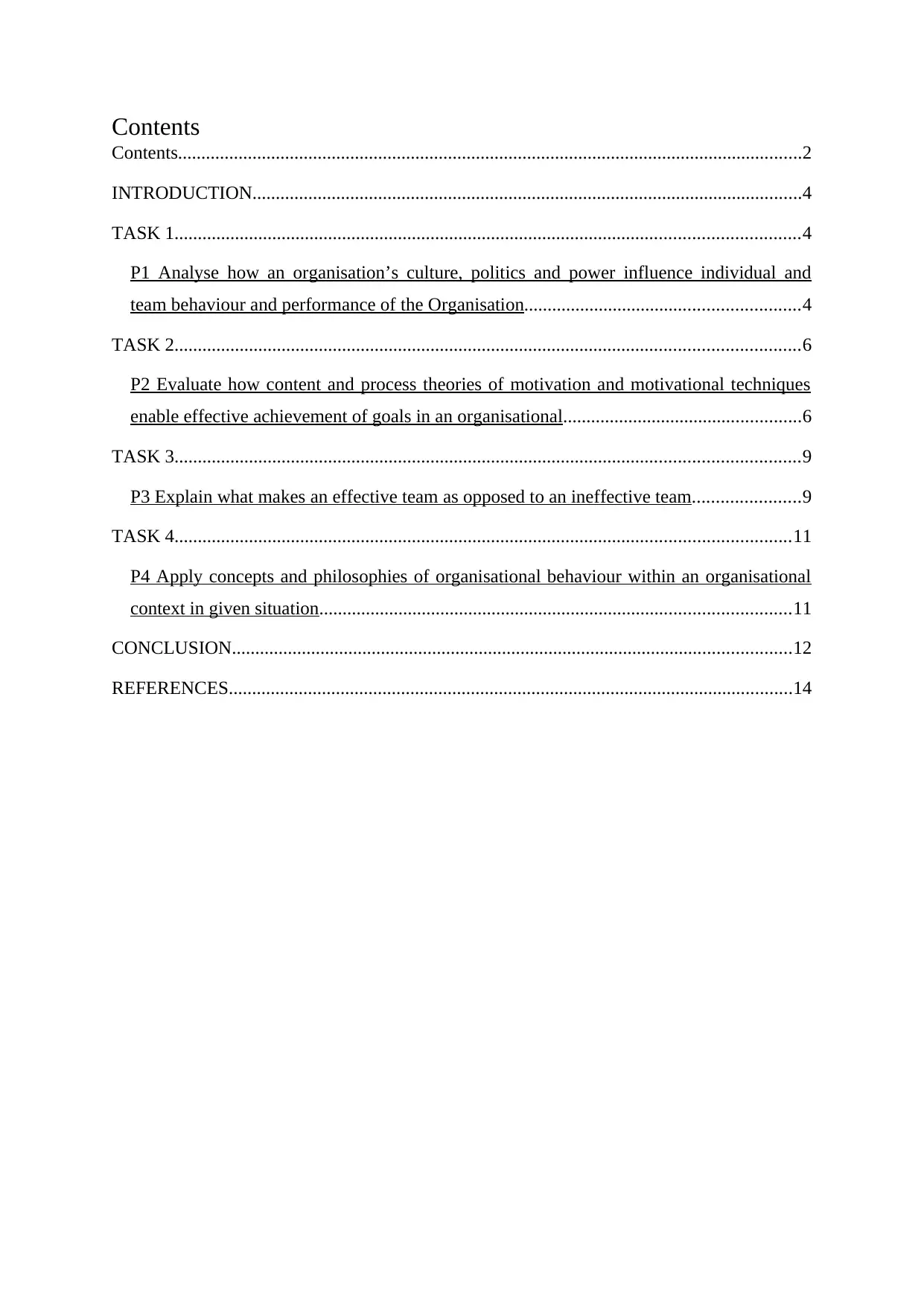
Contents
Contents......................................................................................................................................2
INTRODUCTION......................................................................................................................4
TASK 1......................................................................................................................................4
P1 Analyse how an organisation’s culture, politics and power influence individual and
team behaviour and performance of the Organisation...........................................................4
TASK 2......................................................................................................................................6
P2 Evaluate how content and process theories of motivation and motivational techniques
enable effective achievement of goals in an organisational...................................................6
TASK 3......................................................................................................................................9
P3 Explain what makes an effective team as opposed to an ineffective team.......................9
TASK 4....................................................................................................................................11
P4 Apply concepts and philosophies of organisational behaviour within an organisational
context in given situation.....................................................................................................11
CONCLUSION........................................................................................................................12
REFERENCES.........................................................................................................................14
Contents......................................................................................................................................2
INTRODUCTION......................................................................................................................4
TASK 1......................................................................................................................................4
P1 Analyse how an organisation’s culture, politics and power influence individual and
team behaviour and performance of the Organisation...........................................................4
TASK 2......................................................................................................................................6
P2 Evaluate how content and process theories of motivation and motivational techniques
enable effective achievement of goals in an organisational...................................................6
TASK 3......................................................................................................................................9
P3 Explain what makes an effective team as opposed to an ineffective team.......................9
TASK 4....................................................................................................................................11
P4 Apply concepts and philosophies of organisational behaviour within an organisational
context in given situation.....................................................................................................11
CONCLUSION........................................................................................................................12
REFERENCES.........................................................................................................................14

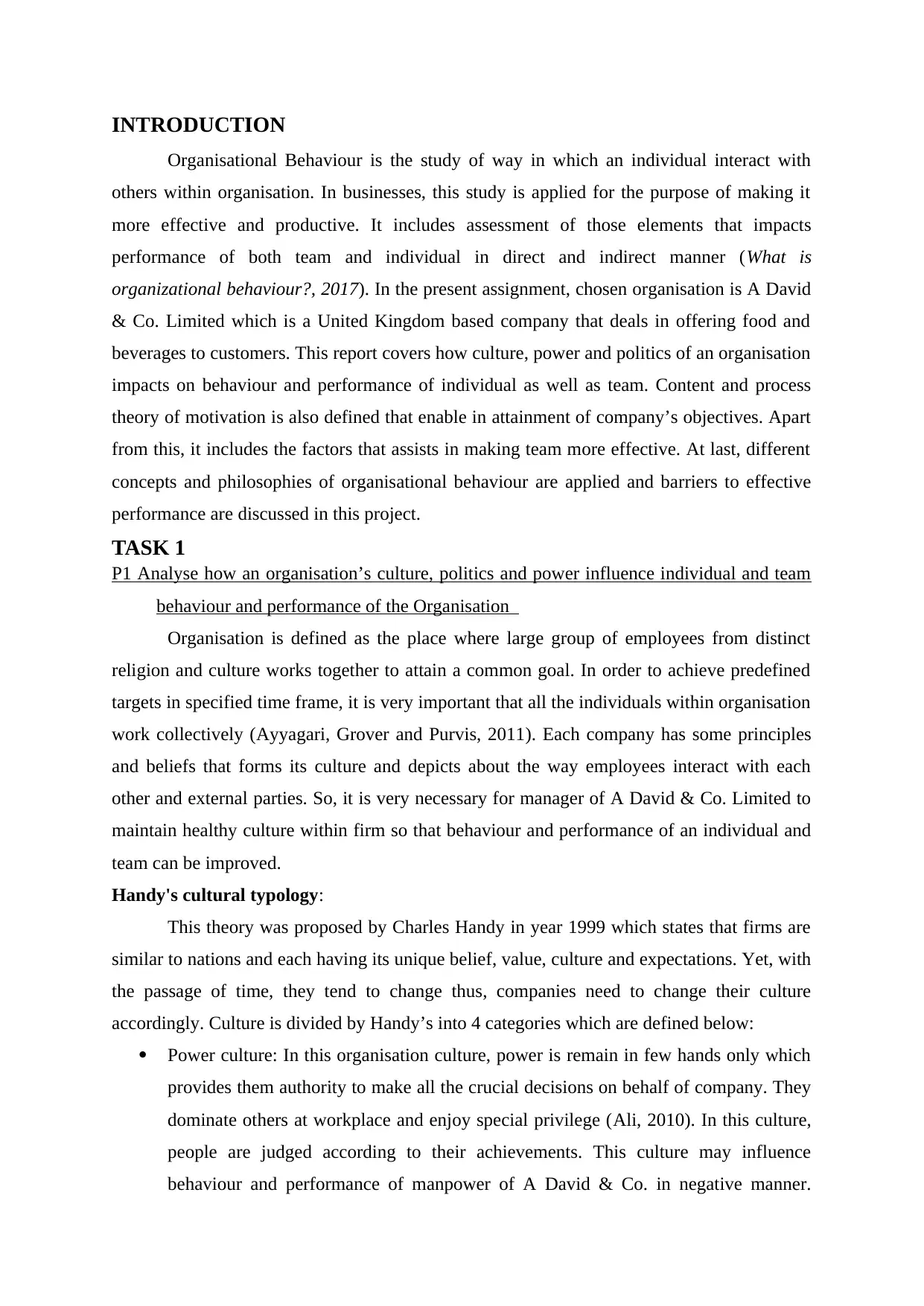
INTRODUCTION
Organisational Behaviour is the study of way in which an individual interact with
others within organisation. In businesses, this study is applied for the purpose of making it
more effective and productive. It includes assessment of those elements that impacts
performance of both team and individual in direct and indirect manner (What is
organizational behaviour?, 2017). In the present assignment, chosen organisation is A David
& Co. Limited which is a United Kingdom based company that deals in offering food and
beverages to customers. This report covers how culture, power and politics of an organisation
impacts on behaviour and performance of individual as well as team. Content and process
theory of motivation is also defined that enable in attainment of company’s objectives. Apart
from this, it includes the factors that assists in making team more effective. At last, different
concepts and philosophies of organisational behaviour are applied and barriers to effective
performance are discussed in this project.
TASK 1
P1 Analyse how an organisation’s culture, politics and power influence individual and team
behaviour and performance of the Organisation
Organisation is defined as the place where large group of employees from distinct
religion and culture works together to attain a common goal. In order to achieve predefined
targets in specified time frame, it is very important that all the individuals within organisation
work collectively (Ayyagari, Grover and Purvis, 2011). Each company has some principles
and beliefs that forms its culture and depicts about the way employees interact with each
other and external parties. So, it is very necessary for manager of A David & Co. Limited to
maintain healthy culture within firm so that behaviour and performance of an individual and
team can be improved.
Handy's cultural typology:
This theory was proposed by Charles Handy in year 1999 which states that firms are
similar to nations and each having its unique belief, value, culture and expectations. Yet, with
the passage of time, they tend to change thus, companies need to change their culture
accordingly. Culture is divided by Handy’s into 4 categories which are defined below:
Power culture: In this organisation culture, power is remain in few hands only which
provides them authority to make all the crucial decisions on behalf of company. They
dominate others at workplace and enjoy special privilege (Ali, 2010). In this culture,
people are judged according to their achievements. This culture may influence
behaviour and performance of manpower of A David & Co. in negative manner.
Organisational Behaviour is the study of way in which an individual interact with
others within organisation. In businesses, this study is applied for the purpose of making it
more effective and productive. It includes assessment of those elements that impacts
performance of both team and individual in direct and indirect manner (What is
organizational behaviour?, 2017). In the present assignment, chosen organisation is A David
& Co. Limited which is a United Kingdom based company that deals in offering food and
beverages to customers. This report covers how culture, power and politics of an organisation
impacts on behaviour and performance of individual as well as team. Content and process
theory of motivation is also defined that enable in attainment of company’s objectives. Apart
from this, it includes the factors that assists in making team more effective. At last, different
concepts and philosophies of organisational behaviour are applied and barriers to effective
performance are discussed in this project.
TASK 1
P1 Analyse how an organisation’s culture, politics and power influence individual and team
behaviour and performance of the Organisation
Organisation is defined as the place where large group of employees from distinct
religion and culture works together to attain a common goal. In order to achieve predefined
targets in specified time frame, it is very important that all the individuals within organisation
work collectively (Ayyagari, Grover and Purvis, 2011). Each company has some principles
and beliefs that forms its culture and depicts about the way employees interact with each
other and external parties. So, it is very necessary for manager of A David & Co. Limited to
maintain healthy culture within firm so that behaviour and performance of an individual and
team can be improved.
Handy's cultural typology:
This theory was proposed by Charles Handy in year 1999 which states that firms are
similar to nations and each having its unique belief, value, culture and expectations. Yet, with
the passage of time, they tend to change thus, companies need to change their culture
accordingly. Culture is divided by Handy’s into 4 categories which are defined below:
Power culture: In this organisation culture, power is remain in few hands only which
provides them authority to make all the crucial decisions on behalf of company. They
dominate others at workplace and enjoy special privilege (Ali, 2010). In this culture,
people are judged according to their achievements. This culture may influence
behaviour and performance of manpower of A David & Co. in negative manner.
Secure Best Marks with AI Grader
Need help grading? Try our AI Grader for instant feedback on your assignments.
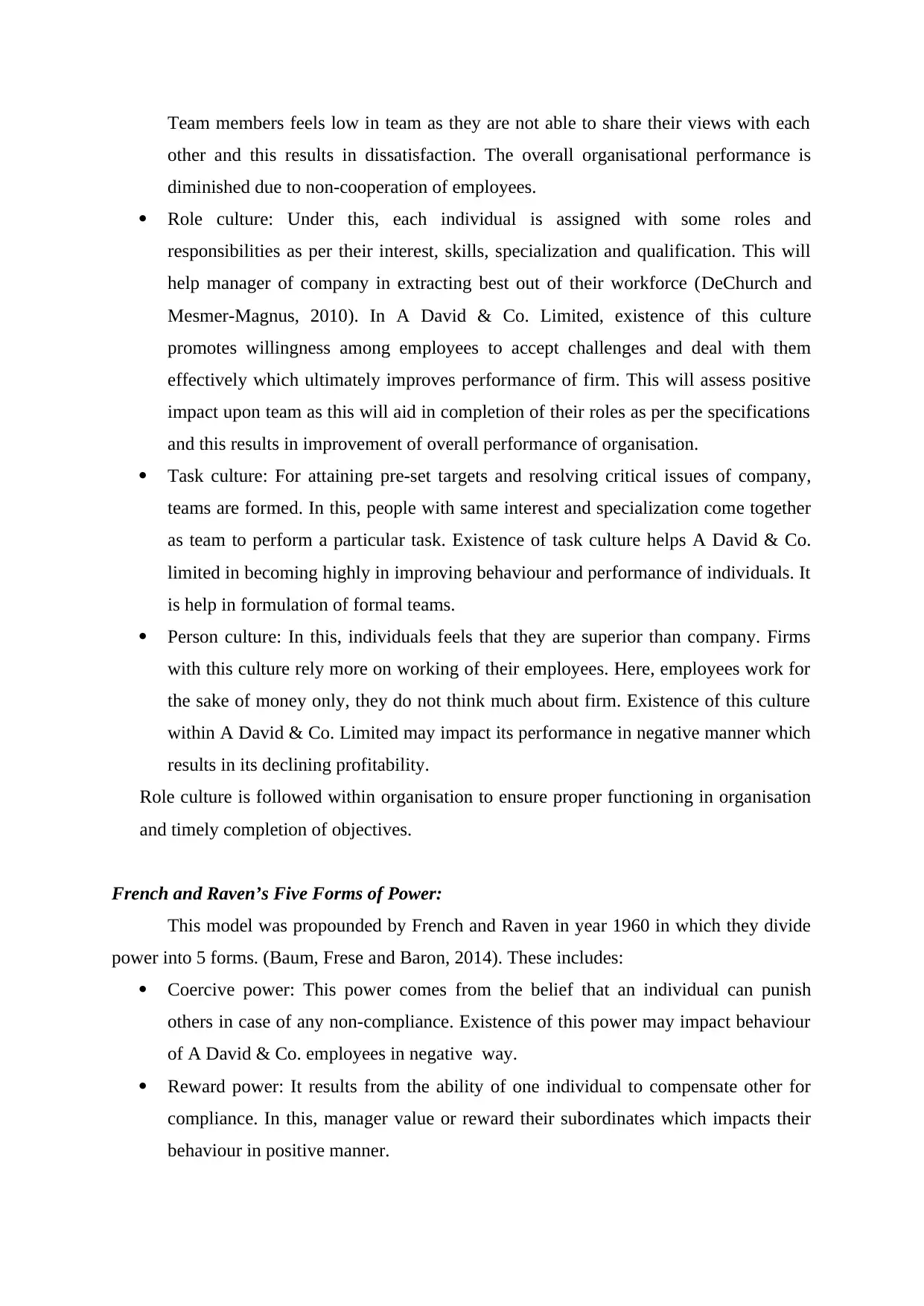
Team members feels low in team as they are not able to share their views with each
other and this results in dissatisfaction. The overall organisational performance is
diminished due to non-cooperation of employees.
Role culture: Under this, each individual is assigned with some roles and
responsibilities as per their interest, skills, specialization and qualification. This will
help manager of company in extracting best out of their workforce (DeChurch and
Mesmer-Magnus, 2010). In A David & Co. Limited, existence of this culture
promotes willingness among employees to accept challenges and deal with them
effectively which ultimately improves performance of firm. This will assess positive
impact upon team as this will aid in completion of their roles as per the specifications
and this results in improvement of overall performance of organisation.
Task culture: For attaining pre-set targets and resolving critical issues of company,
teams are formed. In this, people with same interest and specialization come together
as team to perform a particular task. Existence of task culture helps A David & Co.
limited in becoming highly in improving behaviour and performance of individuals. It
is help in formulation of formal teams.
Person culture: In this, individuals feels that they are superior than company. Firms
with this culture rely more on working of their employees. Here, employees work for
the sake of money only, they do not think much about firm. Existence of this culture
within A David & Co. Limited may impact its performance in negative manner which
results in its declining profitability.
Role culture is followed within organisation to ensure proper functioning in organisation
and timely completion of objectives.
French and Raven’s Five Forms of Power:
This model was propounded by French and Raven in year 1960 in which they divide
power into 5 forms. (Baum, Frese and Baron, 2014). These includes:
Coercive power: This power comes from the belief that an individual can punish
others in case of any non-compliance. Existence of this power may impact behaviour
of A David & Co. employees in negative way.
Reward power: It results from the ability of one individual to compensate other for
compliance. In this, manager value or reward their subordinates which impacts their
behaviour in positive manner.
other and this results in dissatisfaction. The overall organisational performance is
diminished due to non-cooperation of employees.
Role culture: Under this, each individual is assigned with some roles and
responsibilities as per their interest, skills, specialization and qualification. This will
help manager of company in extracting best out of their workforce (DeChurch and
Mesmer-Magnus, 2010). In A David & Co. Limited, existence of this culture
promotes willingness among employees to accept challenges and deal with them
effectively which ultimately improves performance of firm. This will assess positive
impact upon team as this will aid in completion of their roles as per the specifications
and this results in improvement of overall performance of organisation.
Task culture: For attaining pre-set targets and resolving critical issues of company,
teams are formed. In this, people with same interest and specialization come together
as team to perform a particular task. Existence of task culture helps A David & Co.
limited in becoming highly in improving behaviour and performance of individuals. It
is help in formulation of formal teams.
Person culture: In this, individuals feels that they are superior than company. Firms
with this culture rely more on working of their employees. Here, employees work for
the sake of money only, they do not think much about firm. Existence of this culture
within A David & Co. Limited may impact its performance in negative manner which
results in its declining profitability.
Role culture is followed within organisation to ensure proper functioning in organisation
and timely completion of objectives.
French and Raven’s Five Forms of Power:
This model was propounded by French and Raven in year 1960 in which they divide
power into 5 forms. (Baum, Frese and Baron, 2014). These includes:
Coercive power: This power comes from the belief that an individual can punish
others in case of any non-compliance. Existence of this power may impact behaviour
of A David & Co. employees in negative way.
Reward power: It results from the ability of one individual to compensate other for
compliance. In this, manager value or reward their subordinates which impacts their
behaviour in positive manner.
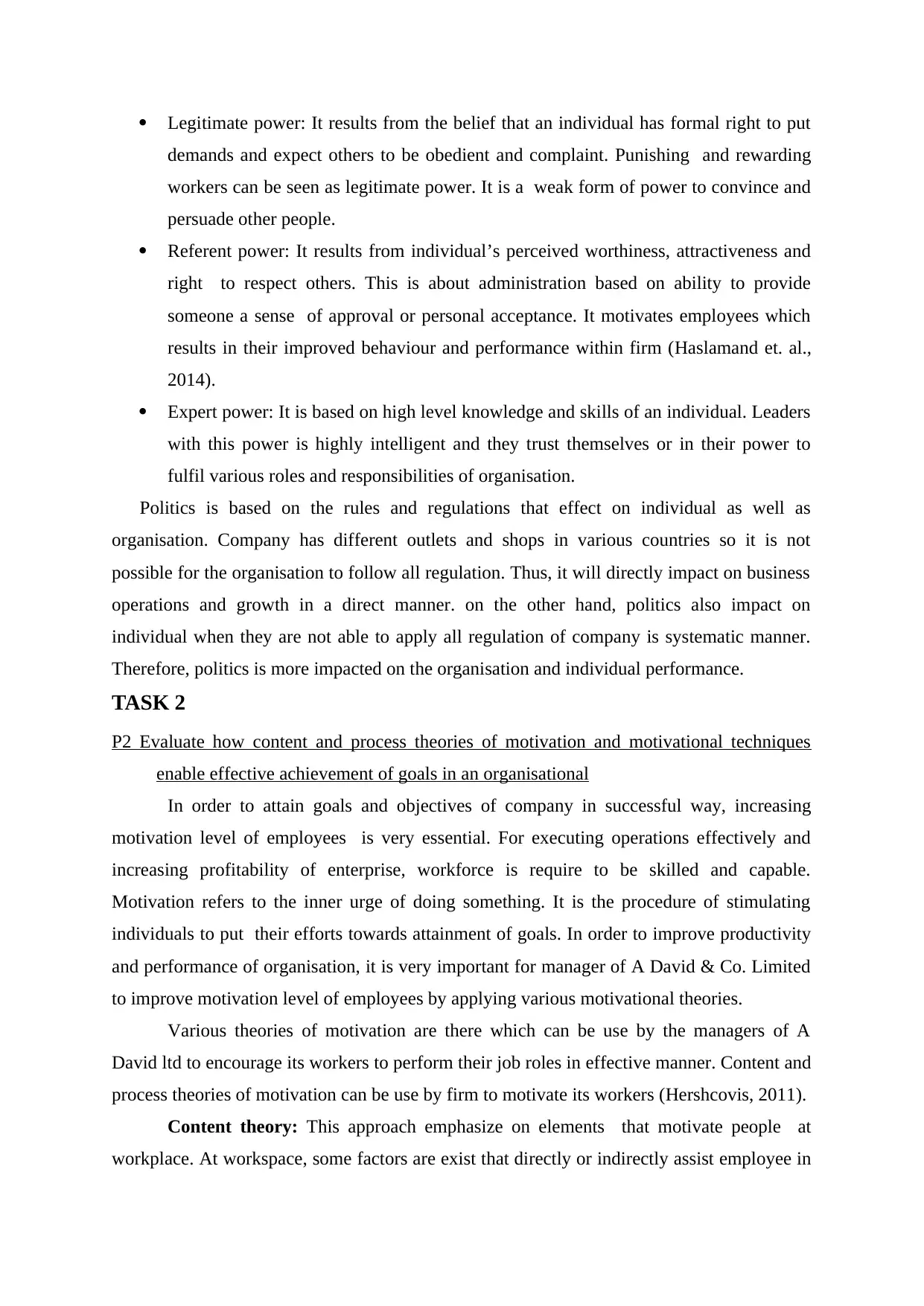
Legitimate power: It results from the belief that an individual has formal right to put
demands and expect others to be obedient and complaint. Punishing and rewarding
workers can be seen as legitimate power. It is a weak form of power to convince and
persuade other people.
Referent power: It results from individual’s perceived worthiness, attractiveness and
right to respect others. This is about administration based on ability to provide
someone a sense of approval or personal acceptance. It motivates employees which
results in their improved behaviour and performance within firm (Haslamand et. al.,
2014).
Expert power: It is based on high level knowledge and skills of an individual. Leaders
with this power is highly intelligent and they trust themselves or in their power to
fulfil various roles and responsibilities of organisation.
Politics is based on the rules and regulations that effect on individual as well as
organisation. Company has different outlets and shops in various countries so it is not
possible for the organisation to follow all regulation. Thus, it will directly impact on business
operations and growth in a direct manner. on the other hand, politics also impact on
individual when they are not able to apply all regulation of company is systematic manner.
Therefore, politics is more impacted on the organisation and individual performance.
TASK 2
P2 Evaluate how content and process theories of motivation and motivational techniques
enable effective achievement of goals in an organisational
In order to attain goals and objectives of company in successful way, increasing
motivation level of employees is very essential. For executing operations effectively and
increasing profitability of enterprise, workforce is require to be skilled and capable.
Motivation refers to the inner urge of doing something. It is the procedure of stimulating
individuals to put their efforts towards attainment of goals. In order to improve productivity
and performance of organisation, it is very important for manager of A David & Co. Limited
to improve motivation level of employees by applying various motivational theories.
Various theories of motivation are there which can be use by the managers of A
David ltd to encourage its workers to perform their job roles in effective manner. Content and
process theories of motivation can be use by firm to motivate its workers (Hershcovis, 2011).
Content theory: This approach emphasize on elements that motivate people at
workplace. At workspace, some factors are exist that directly or indirectly assist employee in
demands and expect others to be obedient and complaint. Punishing and rewarding
workers can be seen as legitimate power. It is a weak form of power to convince and
persuade other people.
Referent power: It results from individual’s perceived worthiness, attractiveness and
right to respect others. This is about administration based on ability to provide
someone a sense of approval or personal acceptance. It motivates employees which
results in their improved behaviour and performance within firm (Haslamand et. al.,
2014).
Expert power: It is based on high level knowledge and skills of an individual. Leaders
with this power is highly intelligent and they trust themselves or in their power to
fulfil various roles and responsibilities of organisation.
Politics is based on the rules and regulations that effect on individual as well as
organisation. Company has different outlets and shops in various countries so it is not
possible for the organisation to follow all regulation. Thus, it will directly impact on business
operations and growth in a direct manner. on the other hand, politics also impact on
individual when they are not able to apply all regulation of company is systematic manner.
Therefore, politics is more impacted on the organisation and individual performance.
TASK 2
P2 Evaluate how content and process theories of motivation and motivational techniques
enable effective achievement of goals in an organisational
In order to attain goals and objectives of company in successful way, increasing
motivation level of employees is very essential. For executing operations effectively and
increasing profitability of enterprise, workforce is require to be skilled and capable.
Motivation refers to the inner urge of doing something. It is the procedure of stimulating
individuals to put their efforts towards attainment of goals. In order to improve productivity
and performance of organisation, it is very important for manager of A David & Co. Limited
to improve motivation level of employees by applying various motivational theories.
Various theories of motivation are there which can be use by the managers of A
David ltd to encourage its workers to perform their job roles in effective manner. Content and
process theories of motivation can be use by firm to motivate its workers (Hershcovis, 2011).
Content theory: This approach emphasize on elements that motivate people at
workplace. At workspace, some factors are exist that directly or indirectly assist employee in
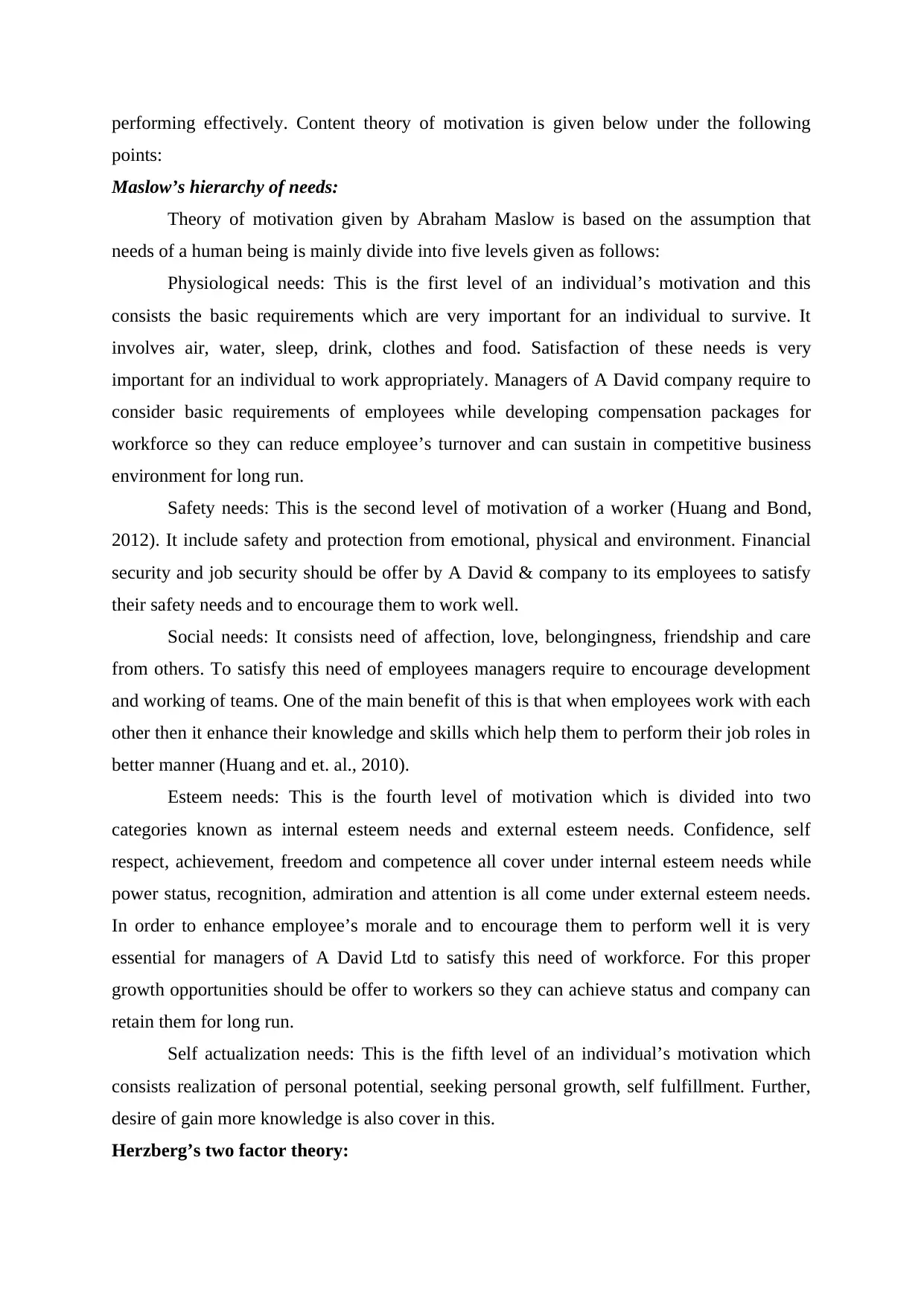
performing effectively. Content theory of motivation is given below under the following
points:
Maslow’s hierarchy of needs:
Theory of motivation given by Abraham Maslow is based on the assumption that
needs of a human being is mainly divide into five levels given as follows:
Physiological needs: This is the first level of an individual’s motivation and this
consists the basic requirements which are very important for an individual to survive. It
involves air, water, sleep, drink, clothes and food. Satisfaction of these needs is very
important for an individual to work appropriately. Managers of A David company require to
consider basic requirements of employees while developing compensation packages for
workforce so they can reduce employee’s turnover and can sustain in competitive business
environment for long run.
Safety needs: This is the second level of motivation of a worker (Huang and Bond,
2012). It include safety and protection from emotional, physical and environment. Financial
security and job security should be offer by A David & company to its employees to satisfy
their safety needs and to encourage them to work well.
Social needs: It consists need of affection, love, belongingness, friendship and care
from others. To satisfy this need of employees managers require to encourage development
and working of teams. One of the main benefit of this is that when employees work with each
other then it enhance their knowledge and skills which help them to perform their job roles in
better manner (Huang and et. al., 2010).
Esteem needs: This is the fourth level of motivation which is divided into two
categories known as internal esteem needs and external esteem needs. Confidence, self
respect, achievement, freedom and competence all cover under internal esteem needs while
power status, recognition, admiration and attention is all come under external esteem needs.
In order to enhance employee’s morale and to encourage them to perform well it is very
essential for managers of A David Ltd to satisfy this need of workforce. For this proper
growth opportunities should be offer to workers so they can achieve status and company can
retain them for long run.
Self actualization needs: This is the fifth level of an individual’s motivation which
consists realization of personal potential, seeking personal growth, self fulfillment. Further,
desire of gain more knowledge is also cover in this.
Herzberg’s two factor theory:
points:
Maslow’s hierarchy of needs:
Theory of motivation given by Abraham Maslow is based on the assumption that
needs of a human being is mainly divide into five levels given as follows:
Physiological needs: This is the first level of an individual’s motivation and this
consists the basic requirements which are very important for an individual to survive. It
involves air, water, sleep, drink, clothes and food. Satisfaction of these needs is very
important for an individual to work appropriately. Managers of A David company require to
consider basic requirements of employees while developing compensation packages for
workforce so they can reduce employee’s turnover and can sustain in competitive business
environment for long run.
Safety needs: This is the second level of motivation of a worker (Huang and Bond,
2012). It include safety and protection from emotional, physical and environment. Financial
security and job security should be offer by A David & company to its employees to satisfy
their safety needs and to encourage them to work well.
Social needs: It consists need of affection, love, belongingness, friendship and care
from others. To satisfy this need of employees managers require to encourage development
and working of teams. One of the main benefit of this is that when employees work with each
other then it enhance their knowledge and skills which help them to perform their job roles in
better manner (Huang and et. al., 2010).
Esteem needs: This is the fourth level of motivation which is divided into two
categories known as internal esteem needs and external esteem needs. Confidence, self
respect, achievement, freedom and competence all cover under internal esteem needs while
power status, recognition, admiration and attention is all come under external esteem needs.
In order to enhance employee’s morale and to encourage them to perform well it is very
essential for managers of A David Ltd to satisfy this need of workforce. For this proper
growth opportunities should be offer to workers so they can achieve status and company can
retain them for long run.
Self actualization needs: This is the fifth level of an individual’s motivation which
consists realization of personal potential, seeking personal growth, self fulfillment. Further,
desire of gain more knowledge is also cover in this.
Herzberg’s two factor theory:
Paraphrase This Document
Need a fresh take? Get an instant paraphrase of this document with our AI Paraphraser
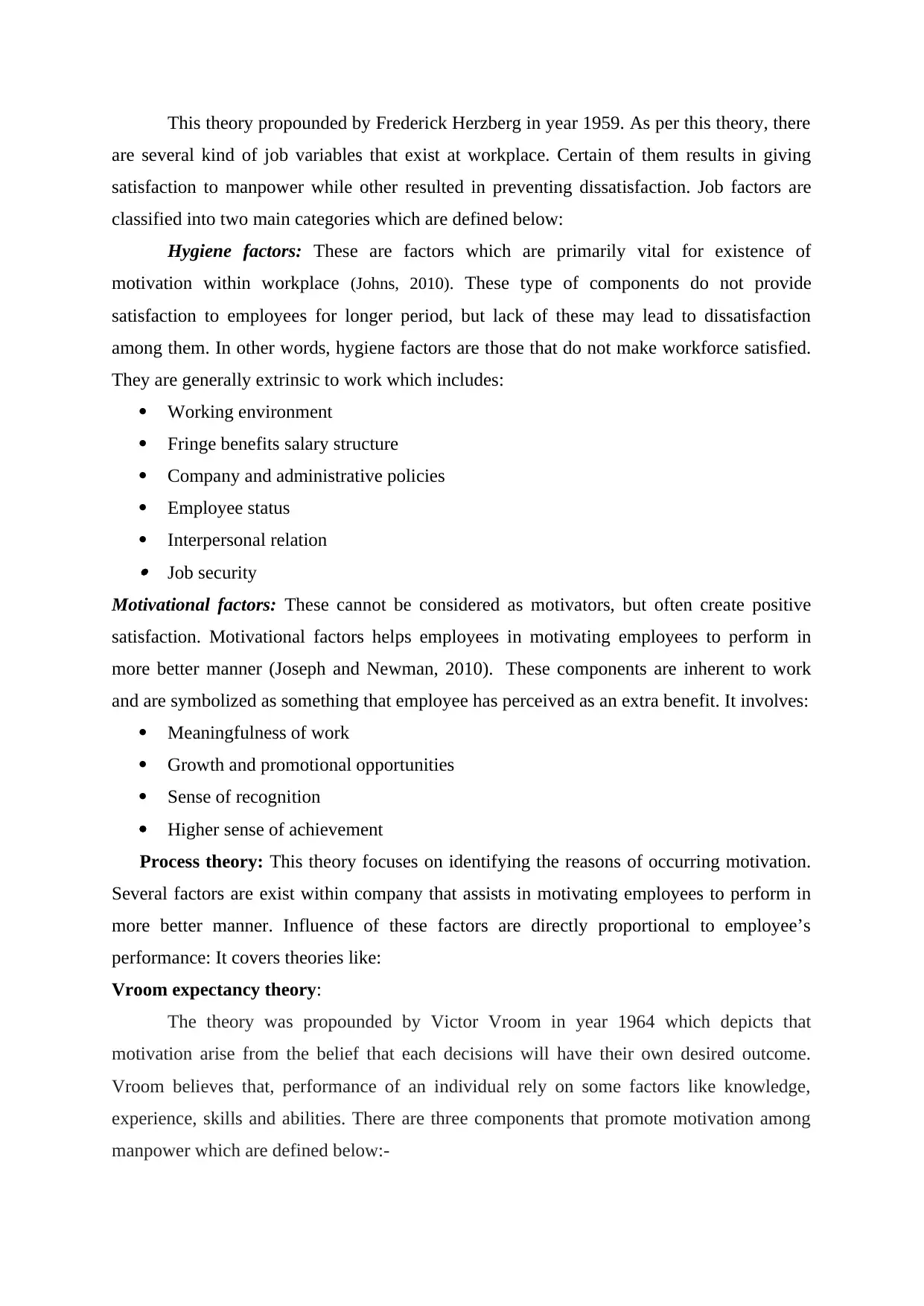
This theory propounded by Frederick Herzberg in year 1959. As per this theory, there
are several kind of job variables that exist at workplace. Certain of them results in giving
satisfaction to manpower while other resulted in preventing dissatisfaction. Job factors are
classified into two main categories which are defined below:
Hygiene factors: These are factors which are primarily vital for existence of
motivation within workplace (Johns, 2010). These type of components do not provide
satisfaction to employees for longer period, but lack of these may lead to dissatisfaction
among them. In other words, hygiene factors are those that do not make workforce satisfied.
They are generally extrinsic to work which includes:
Working environment
Fringe benefits salary structure
Company and administrative policies
Employee status
Interpersonal relation Job security
Motivational factors: These cannot be considered as motivators, but often create positive
satisfaction. Motivational factors helps employees in motivating employees to perform in
more better manner (Joseph and Newman, 2010). These components are inherent to work
and are symbolized as something that employee has perceived as an extra benefit. It involves:
Meaningfulness of work
Growth and promotional opportunities
Sense of recognition
Higher sense of achievement
Process theory: This theory focuses on identifying the reasons of occurring motivation.
Several factors are exist within company that assists in motivating employees to perform in
more better manner. Influence of these factors are directly proportional to employee’s
performance: It covers theories like:
Vroom expectancy theory:
The theory was propounded by Victor Vroom in year 1964 which depicts that
motivation arise from the belief that each decisions will have their own desired outcome.
Vroom believes that, performance of an individual rely on some factors like knowledge,
experience, skills and abilities. There are three components that promote motivation among
manpower which are defined below:-
are several kind of job variables that exist at workplace. Certain of them results in giving
satisfaction to manpower while other resulted in preventing dissatisfaction. Job factors are
classified into two main categories which are defined below:
Hygiene factors: These are factors which are primarily vital for existence of
motivation within workplace (Johns, 2010). These type of components do not provide
satisfaction to employees for longer period, but lack of these may lead to dissatisfaction
among them. In other words, hygiene factors are those that do not make workforce satisfied.
They are generally extrinsic to work which includes:
Working environment
Fringe benefits salary structure
Company and administrative policies
Employee status
Interpersonal relation Job security
Motivational factors: These cannot be considered as motivators, but often create positive
satisfaction. Motivational factors helps employees in motivating employees to perform in
more better manner (Joseph and Newman, 2010). These components are inherent to work
and are symbolized as something that employee has perceived as an extra benefit. It involves:
Meaningfulness of work
Growth and promotional opportunities
Sense of recognition
Higher sense of achievement
Process theory: This theory focuses on identifying the reasons of occurring motivation.
Several factors are exist within company that assists in motivating employees to perform in
more better manner. Influence of these factors are directly proportional to employee’s
performance: It covers theories like:
Vroom expectancy theory:
The theory was propounded by Victor Vroom in year 1964 which depicts that
motivation arise from the belief that each decisions will have their own desired outcome.
Vroom believes that, performance of an individual rely on some factors like knowledge,
experience, skills and abilities. There are three components that promote motivation among
manpower which are defined below:-
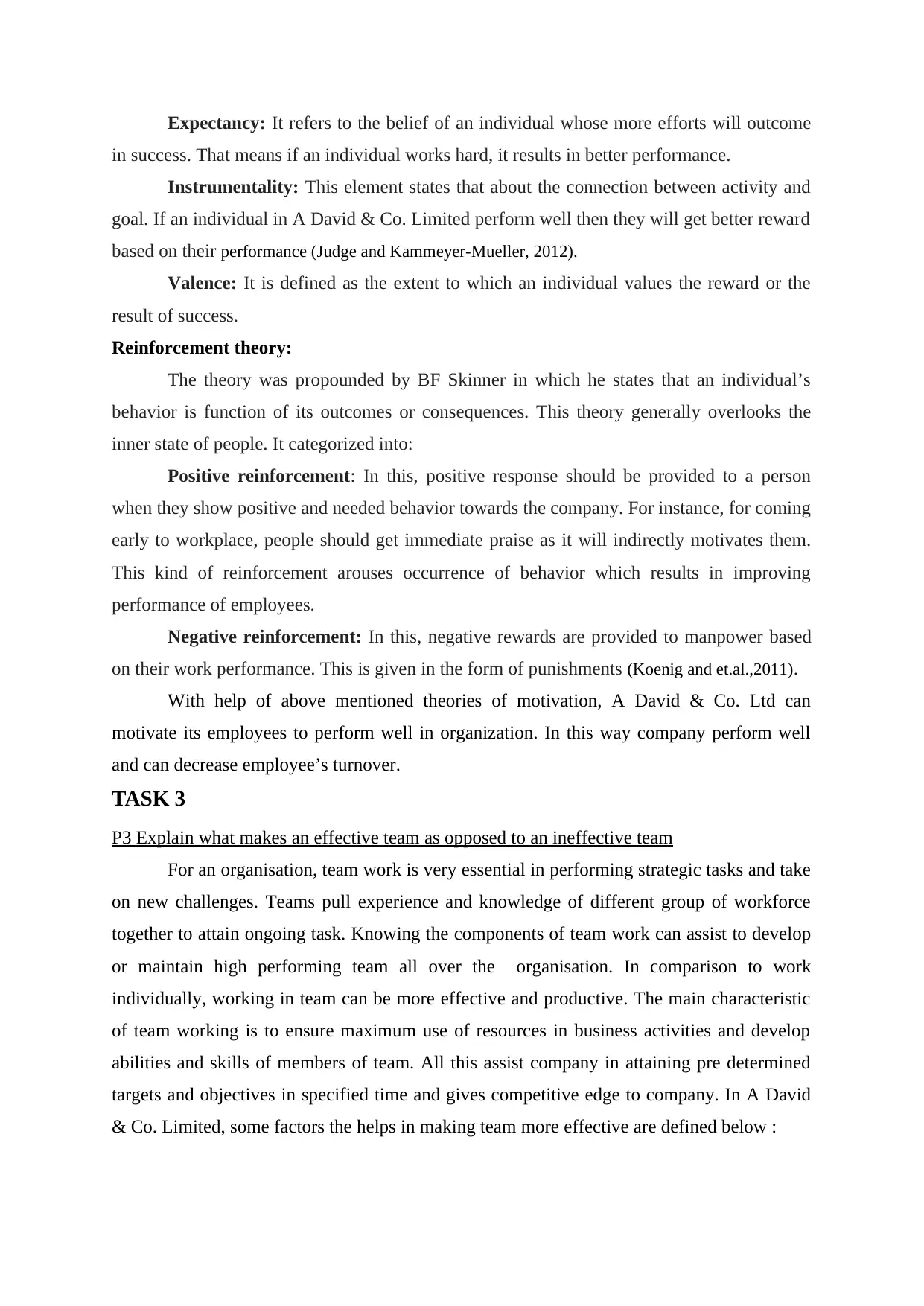
Expectancy: It refers to the belief of an individual whose more efforts will outcome
in success. That means if an individual works hard, it results in better performance.
Instrumentality: This element states that about the connection between activity and
goal. If an individual in A David & Co. Limited perform well then they will get better reward
based on their performance (Judge and Kammeyer‐Mueller, 2012).
Valence: It is defined as the extent to which an individual values the reward or the
result of success.
Reinforcement theory:
The theory was propounded by BF Skinner in which he states that an individual’s
behavior is function of its outcomes or consequences. This theory generally overlooks the
inner state of people. It categorized into:
Positive reinforcement: In this, positive response should be provided to a person
when they show positive and needed behavior towards the company. For instance, for coming
early to workplace, people should get immediate praise as it will indirectly motivates them.
This kind of reinforcement arouses occurrence of behavior which results in improving
performance of employees.
Negative reinforcement: In this, negative rewards are provided to manpower based
on their work performance. This is given in the form of punishments (Koenig and et.al.,2011).
With help of above mentioned theories of motivation, A David & Co. Ltd can
motivate its employees to perform well in organization. In this way company perform well
and can decrease employee’s turnover.
TASK 3
P3 Explain what makes an effective team as opposed to an ineffective team
For an organisation, team work is very essential in performing strategic tasks and take
on new challenges. Teams pull experience and knowledge of different group of workforce
together to attain ongoing task. Knowing the components of team work can assist to develop
or maintain high performing team all over the organisation. In comparison to work
individually, working in team can be more effective and productive. The main characteristic
of team working is to ensure maximum use of resources in business activities and develop
abilities and skills of members of team. All this assist company in attaining pre determined
targets and objectives in specified time and gives competitive edge to company. In A David
& Co. Limited, some factors the helps in making team more effective are defined below :
in success. That means if an individual works hard, it results in better performance.
Instrumentality: This element states that about the connection between activity and
goal. If an individual in A David & Co. Limited perform well then they will get better reward
based on their performance (Judge and Kammeyer‐Mueller, 2012).
Valence: It is defined as the extent to which an individual values the reward or the
result of success.
Reinforcement theory:
The theory was propounded by BF Skinner in which he states that an individual’s
behavior is function of its outcomes or consequences. This theory generally overlooks the
inner state of people. It categorized into:
Positive reinforcement: In this, positive response should be provided to a person
when they show positive and needed behavior towards the company. For instance, for coming
early to workplace, people should get immediate praise as it will indirectly motivates them.
This kind of reinforcement arouses occurrence of behavior which results in improving
performance of employees.
Negative reinforcement: In this, negative rewards are provided to manpower based
on their work performance. This is given in the form of punishments (Koenig and et.al.,2011).
With help of above mentioned theories of motivation, A David & Co. Ltd can
motivate its employees to perform well in organization. In this way company perform well
and can decrease employee’s turnover.
TASK 3
P3 Explain what makes an effective team as opposed to an ineffective team
For an organisation, team work is very essential in performing strategic tasks and take
on new challenges. Teams pull experience and knowledge of different group of workforce
together to attain ongoing task. Knowing the components of team work can assist to develop
or maintain high performing team all over the organisation. In comparison to work
individually, working in team can be more effective and productive. The main characteristic
of team working is to ensure maximum use of resources in business activities and develop
abilities and skills of members of team. All this assist company in attaining pre determined
targets and objectives in specified time and gives competitive edge to company. In A David
& Co. Limited, some factors the helps in making team more effective are defined below :
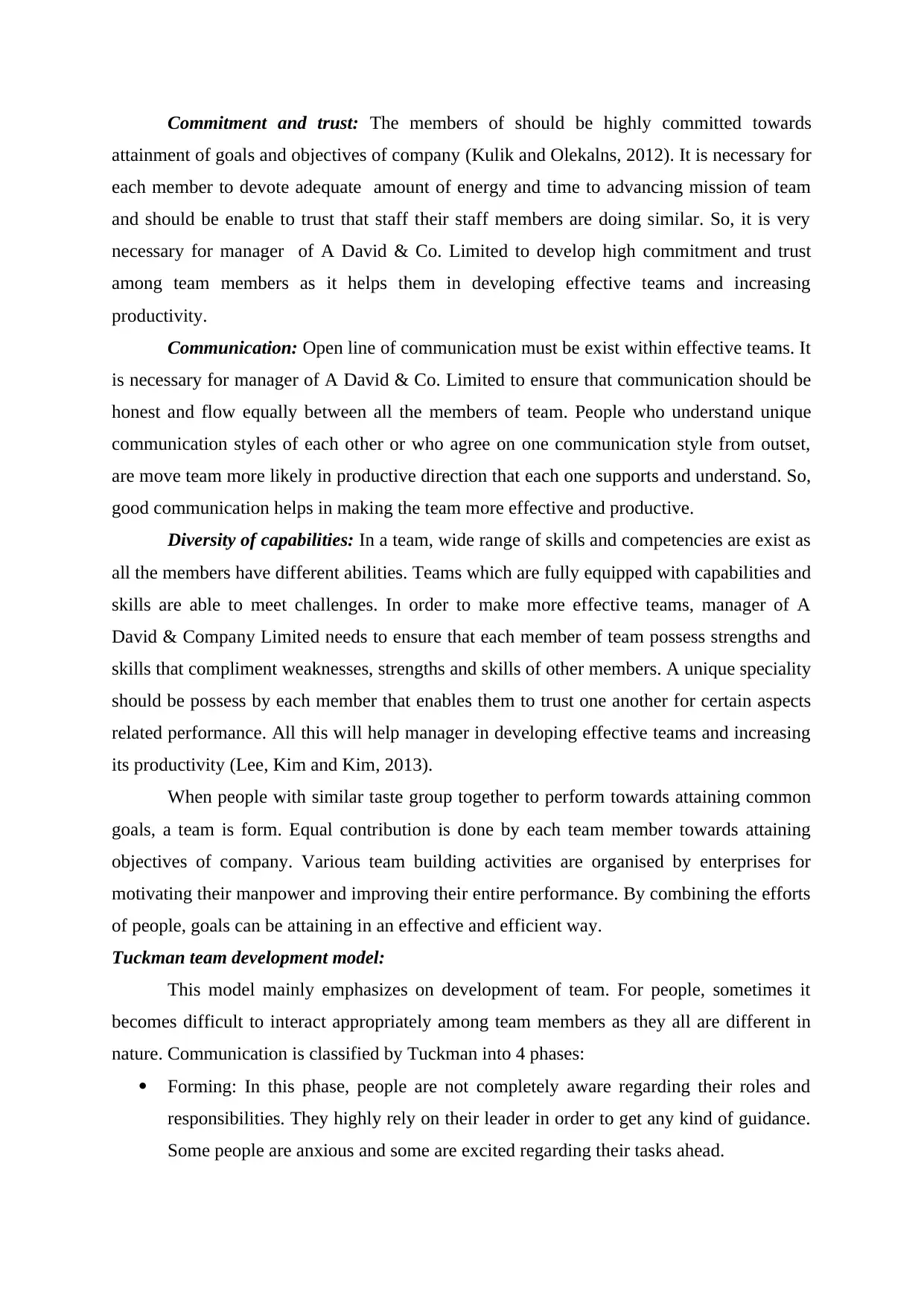
Commitment and trust: The members of should be highly committed towards
attainment of goals and objectives of company (Kulik and Olekalns, 2012). It is necessary for
each member to devote adequate amount of energy and time to advancing mission of team
and should be enable to trust that staff their staff members are doing similar. So, it is very
necessary for manager of A David & Co. Limited to develop high commitment and trust
among team members as it helps them in developing effective teams and increasing
productivity.
Communication: Open line of communication must be exist within effective teams. It
is necessary for manager of A David & Co. Limited to ensure that communication should be
honest and flow equally between all the members of team. People who understand unique
communication styles of each other or who agree on one communication style from outset,
are move team more likely in productive direction that each one supports and understand. So,
good communication helps in making the team more effective and productive.
Diversity of capabilities: In a team, wide range of skills and competencies are exist as
all the members have different abilities. Teams which are fully equipped with capabilities and
skills are able to meet challenges. In order to make more effective teams, manager of A
David & Company Limited needs to ensure that each member of team possess strengths and
skills that compliment weaknesses, strengths and skills of other members. A unique speciality
should be possess by each member that enables them to trust one another for certain aspects
related performance. All this will help manager in developing effective teams and increasing
its productivity (Lee, Kim and Kim, 2013).
When people with similar taste group together to perform towards attaining common
goals, a team is form. Equal contribution is done by each team member towards attaining
objectives of company. Various team building activities are organised by enterprises for
motivating their manpower and improving their entire performance. By combining the efforts
of people, goals can be attaining in an effective and efficient way.
Tuckman team development model:
This model mainly emphasizes on development of team. For people, sometimes it
becomes difficult to interact appropriately among team members as they all are different in
nature. Communication is classified by Tuckman into 4 phases:
Forming: In this phase, people are not completely aware regarding their roles and
responsibilities. They highly rely on their leader in order to get any kind of guidance.
Some people are anxious and some are excited regarding their tasks ahead.
attainment of goals and objectives of company (Kulik and Olekalns, 2012). It is necessary for
each member to devote adequate amount of energy and time to advancing mission of team
and should be enable to trust that staff their staff members are doing similar. So, it is very
necessary for manager of A David & Co. Limited to develop high commitment and trust
among team members as it helps them in developing effective teams and increasing
productivity.
Communication: Open line of communication must be exist within effective teams. It
is necessary for manager of A David & Co. Limited to ensure that communication should be
honest and flow equally between all the members of team. People who understand unique
communication styles of each other or who agree on one communication style from outset,
are move team more likely in productive direction that each one supports and understand. So,
good communication helps in making the team more effective and productive.
Diversity of capabilities: In a team, wide range of skills and competencies are exist as
all the members have different abilities. Teams which are fully equipped with capabilities and
skills are able to meet challenges. In order to make more effective teams, manager of A
David & Company Limited needs to ensure that each member of team possess strengths and
skills that compliment weaknesses, strengths and skills of other members. A unique speciality
should be possess by each member that enables them to trust one another for certain aspects
related performance. All this will help manager in developing effective teams and increasing
its productivity (Lee, Kim and Kim, 2013).
When people with similar taste group together to perform towards attaining common
goals, a team is form. Equal contribution is done by each team member towards attaining
objectives of company. Various team building activities are organised by enterprises for
motivating their manpower and improving their entire performance. By combining the efforts
of people, goals can be attaining in an effective and efficient way.
Tuckman team development model:
This model mainly emphasizes on development of team. For people, sometimes it
becomes difficult to interact appropriately among team members as they all are different in
nature. Communication is classified by Tuckman into 4 phases:
Forming: In this phase, people are not completely aware regarding their roles and
responsibilities. They highly rely on their leader in order to get any kind of guidance.
Some people are anxious and some are excited regarding their tasks ahead.
Secure Best Marks with AI Grader
Need help grading? Try our AI Grader for instant feedback on your assignments.
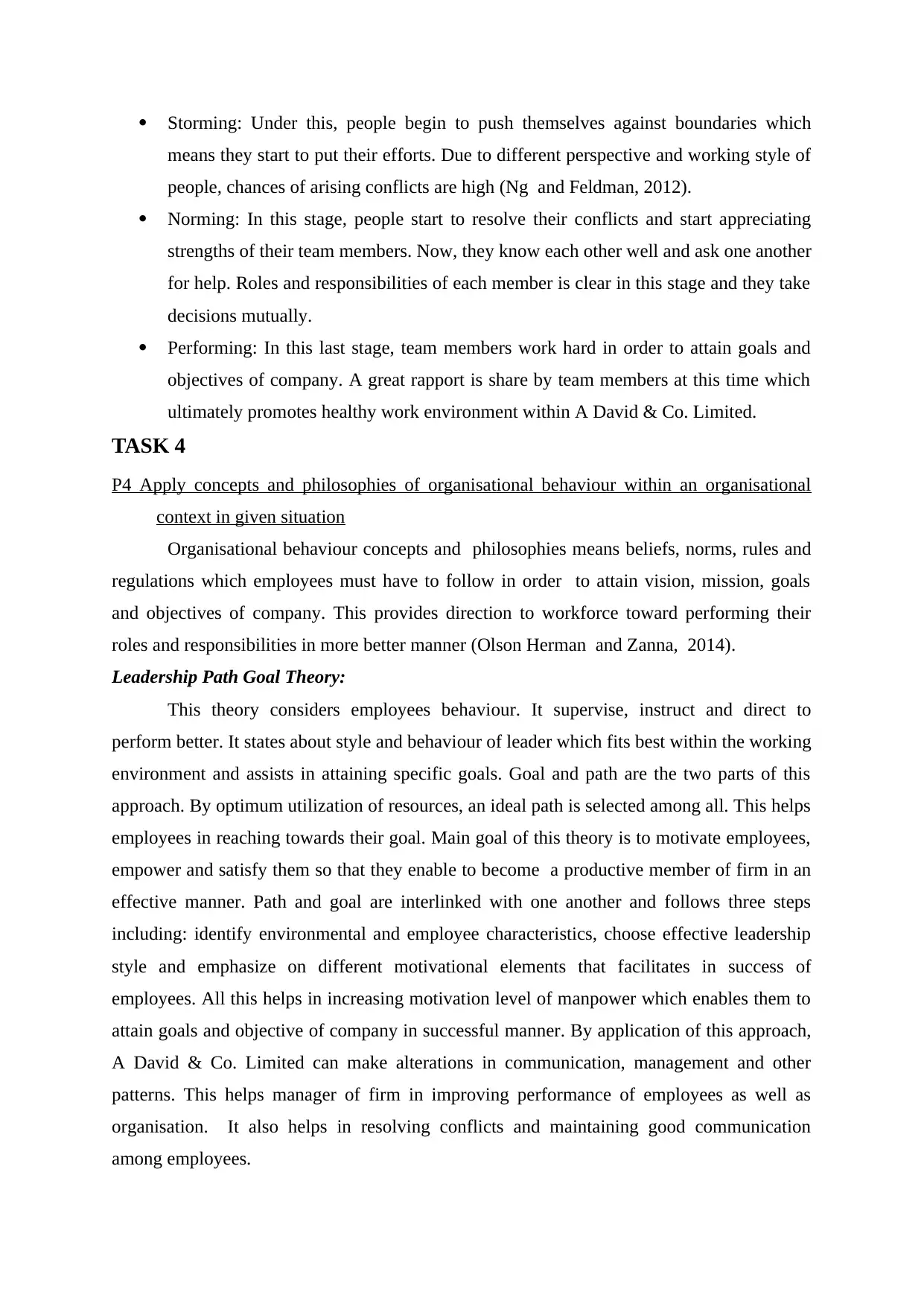
Storming: Under this, people begin to push themselves against boundaries which
means they start to put their efforts. Due to different perspective and working style of
people, chances of arising conflicts are high (Ng and Feldman, 2012).
Norming: In this stage, people start to resolve their conflicts and start appreciating
strengths of their team members. Now, they know each other well and ask one another
for help. Roles and responsibilities of each member is clear in this stage and they take
decisions mutually.
Performing: In this last stage, team members work hard in order to attain goals and
objectives of company. A great rapport is share by team members at this time which
ultimately promotes healthy work environment within A David & Co. Limited.
TASK 4
P4 Apply concepts and philosophies of organisational behaviour within an organisational
context in given situation
Organisational behaviour concepts and philosophies means beliefs, norms, rules and
regulations which employees must have to follow in order to attain vision, mission, goals
and objectives of company. This provides direction to workforce toward performing their
roles and responsibilities in more better manner (Olson Herman and Zanna, 2014).
Leadership Path Goal Theory:
This theory considers employees behaviour. It supervise, instruct and direct to
perform better. It states about style and behaviour of leader which fits best within the working
environment and assists in attaining specific goals. Goal and path are the two parts of this
approach. By optimum utilization of resources, an ideal path is selected among all. This helps
employees in reaching towards their goal. Main goal of this theory is to motivate employees,
empower and satisfy them so that they enable to become a productive member of firm in an
effective manner. Path and goal are interlinked with one another and follows three steps
including: identify environmental and employee characteristics, choose effective leadership
style and emphasize on different motivational elements that facilitates in success of
employees. All this helps in increasing motivation level of manpower which enables them to
attain goals and objective of company in successful manner. By application of this approach,
A David & Co. Limited can make alterations in communication, management and other
patterns. This helps manager of firm in improving performance of employees as well as
organisation. It also helps in resolving conflicts and maintaining good communication
among employees.
means they start to put their efforts. Due to different perspective and working style of
people, chances of arising conflicts are high (Ng and Feldman, 2012).
Norming: In this stage, people start to resolve their conflicts and start appreciating
strengths of their team members. Now, they know each other well and ask one another
for help. Roles and responsibilities of each member is clear in this stage and they take
decisions mutually.
Performing: In this last stage, team members work hard in order to attain goals and
objectives of company. A great rapport is share by team members at this time which
ultimately promotes healthy work environment within A David & Co. Limited.
TASK 4
P4 Apply concepts and philosophies of organisational behaviour within an organisational
context in given situation
Organisational behaviour concepts and philosophies means beliefs, norms, rules and
regulations which employees must have to follow in order to attain vision, mission, goals
and objectives of company. This provides direction to workforce toward performing their
roles and responsibilities in more better manner (Olson Herman and Zanna, 2014).
Leadership Path Goal Theory:
This theory considers employees behaviour. It supervise, instruct and direct to
perform better. It states about style and behaviour of leader which fits best within the working
environment and assists in attaining specific goals. Goal and path are the two parts of this
approach. By optimum utilization of resources, an ideal path is selected among all. This helps
employees in reaching towards their goal. Main goal of this theory is to motivate employees,
empower and satisfy them so that they enable to become a productive member of firm in an
effective manner. Path and goal are interlinked with one another and follows three steps
including: identify environmental and employee characteristics, choose effective leadership
style and emphasize on different motivational elements that facilitates in success of
employees. All this helps in increasing motivation level of manpower which enables them to
attain goals and objective of company in successful manner. By application of this approach,
A David & Co. Limited can make alterations in communication, management and other
patterns. This helps manager of firm in improving performance of employees as well as
organisation. It also helps in resolving conflicts and maintaining good communication
among employees.
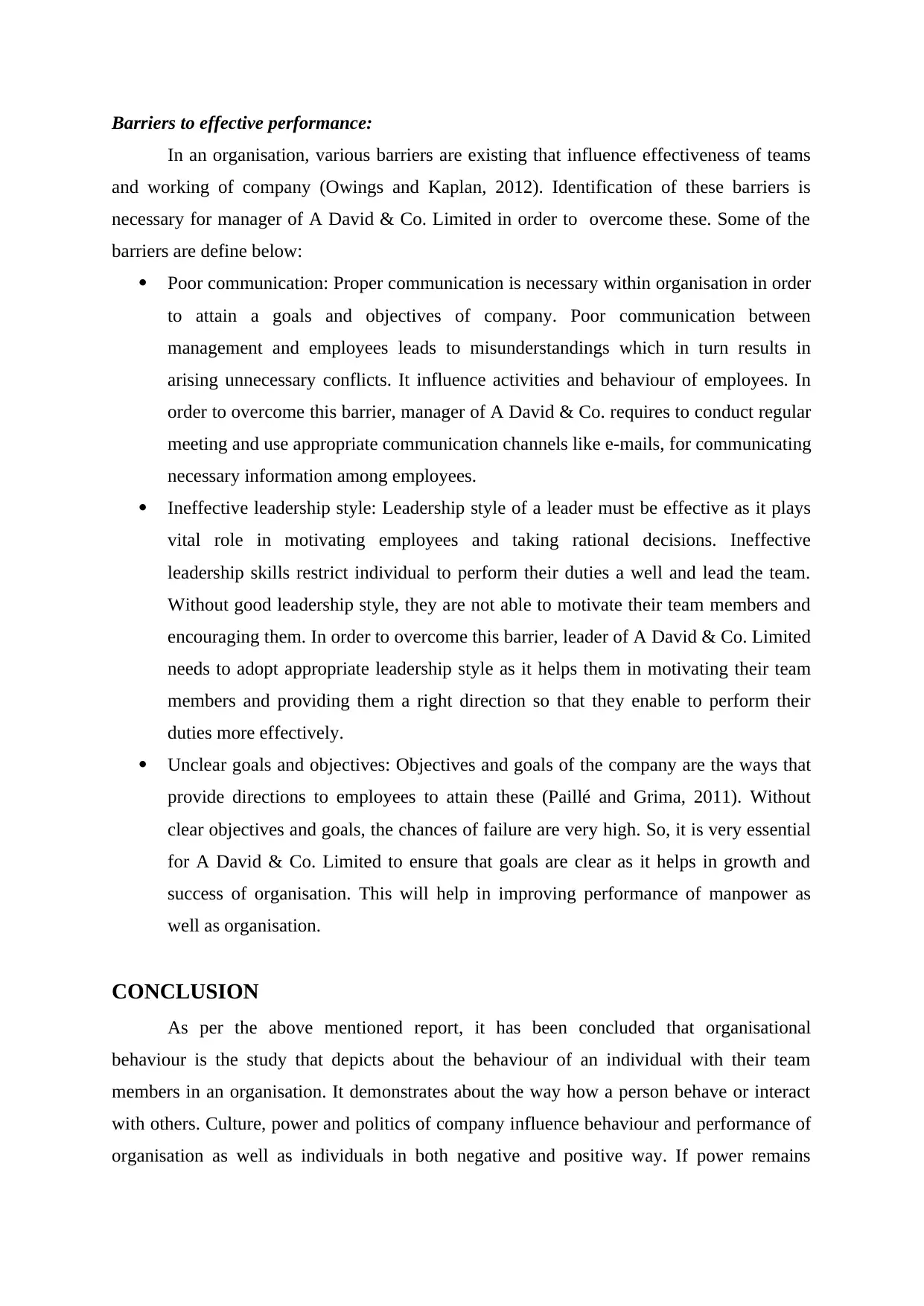
Barriers to effective performance:
In an organisation, various barriers are existing that influence effectiveness of teams
and working of company (Owings and Kaplan, 2012). Identification of these barriers is
necessary for manager of A David & Co. Limited in order to overcome these. Some of the
barriers are define below:
Poor communication: Proper communication is necessary within organisation in order
to attain a goals and objectives of company. Poor communication between
management and employees leads to misunderstandings which in turn results in
arising unnecessary conflicts. It influence activities and behaviour of employees. In
order to overcome this barrier, manager of A David & Co. requires to conduct regular
meeting and use appropriate communication channels like e-mails, for communicating
necessary information among employees.
Ineffective leadership style: Leadership style of a leader must be effective as it plays
vital role in motivating employees and taking rational decisions. Ineffective
leadership skills restrict individual to perform their duties a well and lead the team.
Without good leadership style, they are not able to motivate their team members and
encouraging them. In order to overcome this barrier, leader of A David & Co. Limited
needs to adopt appropriate leadership style as it helps them in motivating their team
members and providing them a right direction so that they enable to perform their
duties more effectively.
Unclear goals and objectives: Objectives and goals of the company are the ways that
provide directions to employees to attain these (Paillé and Grima, 2011). Without
clear objectives and goals, the chances of failure are very high. So, it is very essential
for A David & Co. Limited to ensure that goals are clear as it helps in growth and
success of organisation. This will help in improving performance of manpower as
well as organisation.
CONCLUSION
As per the above mentioned report, it has been concluded that organisational
behaviour is the study that depicts about the behaviour of an individual with their team
members in an organisation. It demonstrates about the way how a person behave or interact
with others. Culture, power and politics of company influence behaviour and performance of
organisation as well as individuals in both negative and positive way. If power remains
In an organisation, various barriers are existing that influence effectiveness of teams
and working of company (Owings and Kaplan, 2012). Identification of these barriers is
necessary for manager of A David & Co. Limited in order to overcome these. Some of the
barriers are define below:
Poor communication: Proper communication is necessary within organisation in order
to attain a goals and objectives of company. Poor communication between
management and employees leads to misunderstandings which in turn results in
arising unnecessary conflicts. It influence activities and behaviour of employees. In
order to overcome this barrier, manager of A David & Co. requires to conduct regular
meeting and use appropriate communication channels like e-mails, for communicating
necessary information among employees.
Ineffective leadership style: Leadership style of a leader must be effective as it plays
vital role in motivating employees and taking rational decisions. Ineffective
leadership skills restrict individual to perform their duties a well and lead the team.
Without good leadership style, they are not able to motivate their team members and
encouraging them. In order to overcome this barrier, leader of A David & Co. Limited
needs to adopt appropriate leadership style as it helps them in motivating their team
members and providing them a right direction so that they enable to perform their
duties more effectively.
Unclear goals and objectives: Objectives and goals of the company are the ways that
provide directions to employees to attain these (Paillé and Grima, 2011). Without
clear objectives and goals, the chances of failure are very high. So, it is very essential
for A David & Co. Limited to ensure that goals are clear as it helps in growth and
success of organisation. This will help in improving performance of manpower as
well as organisation.
CONCLUSION
As per the above mentioned report, it has been concluded that organisational
behaviour is the study that depicts about the behaviour of an individual with their team
members in an organisation. It demonstrates about the way how a person behave or interact
with others. Culture, power and politics of company influence behaviour and performance of
organisation as well as individuals in both negative and positive way. If power remains
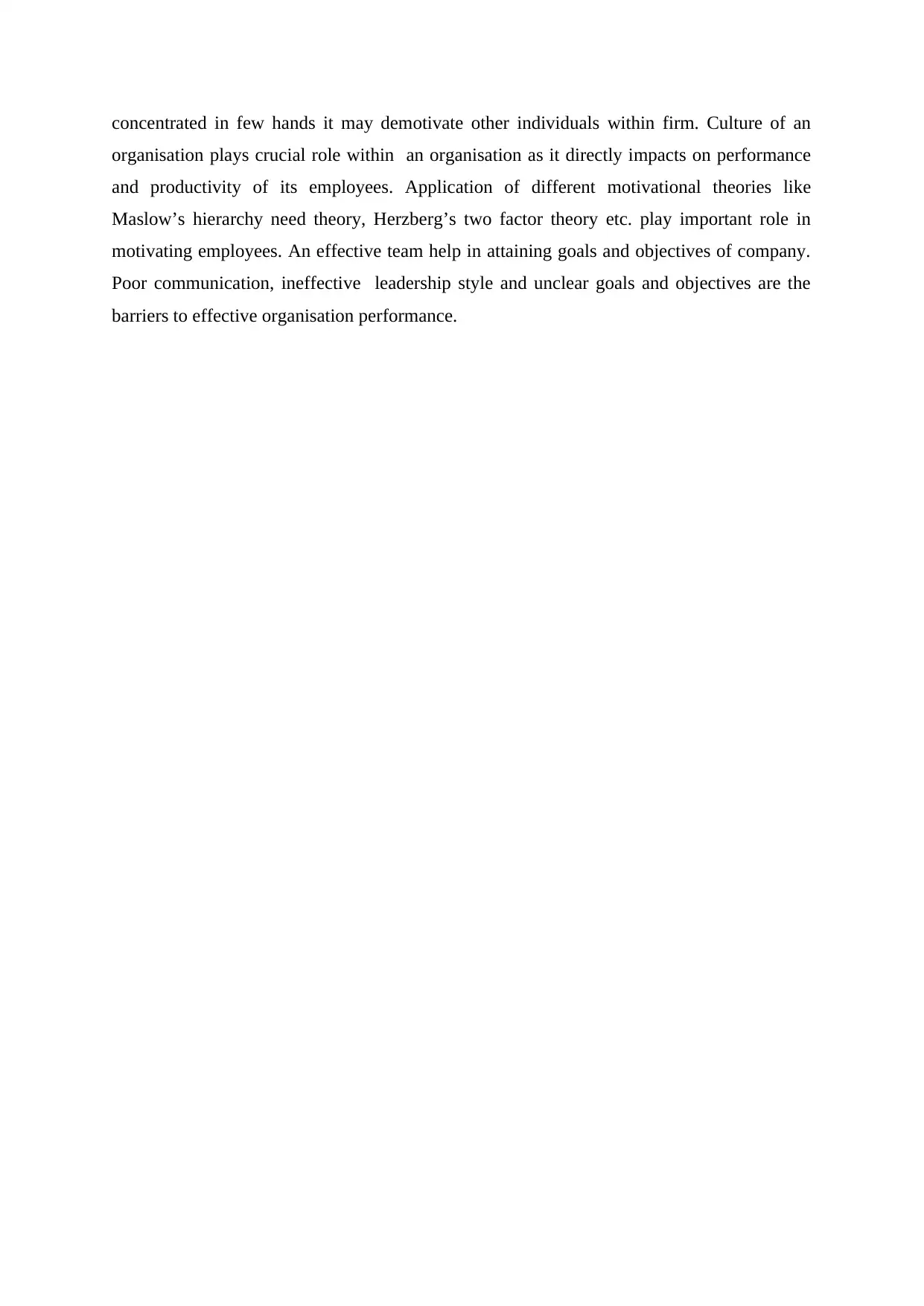
concentrated in few hands it may demotivate other individuals within firm. Culture of an
organisation plays crucial role within an organisation as it directly impacts on performance
and productivity of its employees. Application of different motivational theories like
Maslow’s hierarchy need theory, Herzberg’s two factor theory etc. play important role in
motivating employees. An effective team help in attaining goals and objectives of company.
Poor communication, ineffective leadership style and unclear goals and objectives are the
barriers to effective organisation performance.
organisation plays crucial role within an organisation as it directly impacts on performance
and productivity of its employees. Application of different motivational theories like
Maslow’s hierarchy need theory, Herzberg’s two factor theory etc. play important role in
motivating employees. An effective team help in attaining goals and objectives of company.
Poor communication, ineffective leadership style and unclear goals and objectives are the
barriers to effective organisation performance.
Paraphrase This Document
Need a fresh take? Get an instant paraphrase of this document with our AI Paraphraser
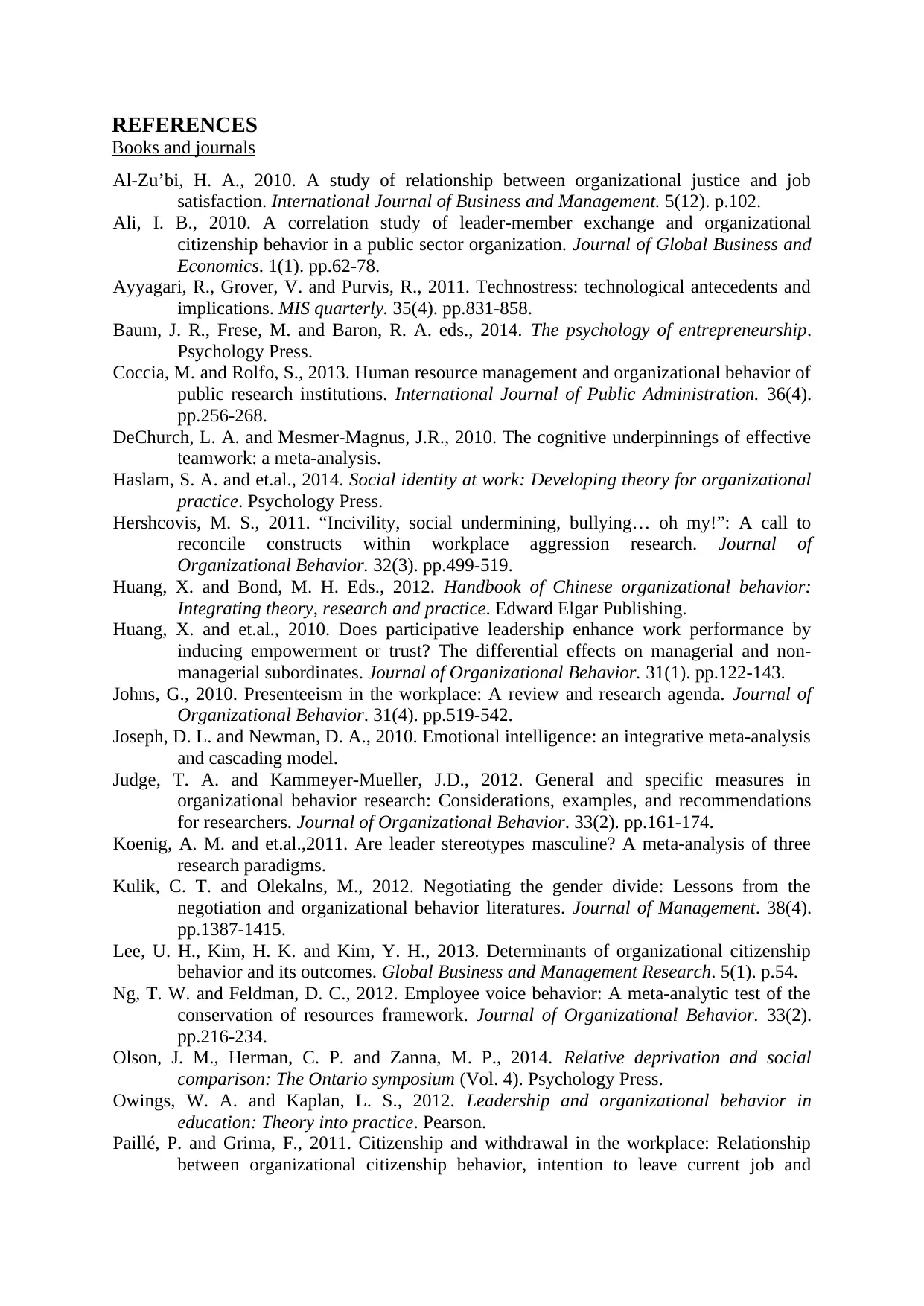
REFERENCES
Books and journals
Al-Zu’bi, H. A., 2010. A study of relationship between organizational justice and job
satisfaction. International Journal of Business and Management. 5(12). p.102.
Ali, I. B., 2010. A correlation study of leader-member exchange and organizational
citizenship behavior in a public sector organization. Journal of Global Business and
Economics. 1(1). pp.62-78.
Ayyagari, R., Grover, V. and Purvis, R., 2011. Technostress: technological antecedents and
implications. MIS quarterly. 35(4). pp.831-858.
Baum, J. R., Frese, M. and Baron, R. A. eds., 2014. The psychology of entrepreneurship.
Psychology Press.
Coccia, M. and Rolfo, S., 2013. Human resource management and organizational behavior of
public research institutions. International Journal of Public Administration. 36(4).
pp.256-268.
DeChurch, L. A. and Mesmer-Magnus, J.R., 2010. The cognitive underpinnings of effective
teamwork: a meta-analysis.
Haslam, S. A. and et.al., 2014. Social identity at work: Developing theory for organizational
practice. Psychology Press.
Hershcovis, M. S., 2011. “Incivility, social undermining, bullying… oh my!”: A call to
reconcile constructs within workplace aggression research. Journal of
Organizational Behavior. 32(3). pp.499-519.
Huang, X. and Bond, M. H. Eds., 2012. Handbook of Chinese organizational behavior:
Integrating theory, research and practice. Edward Elgar Publishing.
Huang, X. and et.al., 2010. Does participative leadership enhance work performance by
inducing empowerment or trust? The differential effects on managerial and non‐
managerial subordinates. Journal of Organizational Behavior. 31(1). pp.122-143.
Johns, G., 2010. Presenteeism in the workplace: A review and research agenda. Journal of
Organizational Behavior. 31(4). pp.519-542.
Joseph, D. L. and Newman, D. A., 2010. Emotional intelligence: an integrative meta-analysis
and cascading model.
Judge, T. A. and Kammeyer‐Mueller, J.D., 2012. General and specific measures in
organizational behavior research: Considerations, examples, and recommendations
for researchers. Journal of Organizational Behavior. 33(2). pp.161-174.
Koenig, A. M. and et.al.,2011. Are leader stereotypes masculine? A meta-analysis of three
research paradigms.
Kulik, C. T. and Olekalns, M., 2012. Negotiating the gender divide: Lessons from the
negotiation and organizational behavior literatures. Journal of Management. 38(4).
pp.1387-1415.
Lee, U. H., Kim, H. K. and Kim, Y. H., 2013. Determinants of organizational citizenship
behavior and its outcomes. Global Business and Management Research. 5(1). p.54.
Ng, T. W. and Feldman, D. C., 2012. Employee voice behavior: A meta‐analytic test of the
conservation of resources framework. Journal of Organizational Behavior. 33(2).
pp.216-234.
Olson, J. M., Herman, C. P. and Zanna, M. P., 2014. Relative deprivation and social
comparison: The Ontario symposium (Vol. 4). Psychology Press.
Owings, W. A. and Kaplan, L. S., 2012. Leadership and organizational behavior in
education: Theory into practice. Pearson.
Paillé, P. and Grima, F., 2011. Citizenship and withdrawal in the workplace: Relationship
between organizational citizenship behavior, intention to leave current job and
Books and journals
Al-Zu’bi, H. A., 2010. A study of relationship between organizational justice and job
satisfaction. International Journal of Business and Management. 5(12). p.102.
Ali, I. B., 2010. A correlation study of leader-member exchange and organizational
citizenship behavior in a public sector organization. Journal of Global Business and
Economics. 1(1). pp.62-78.
Ayyagari, R., Grover, V. and Purvis, R., 2011. Technostress: technological antecedents and
implications. MIS quarterly. 35(4). pp.831-858.
Baum, J. R., Frese, M. and Baron, R. A. eds., 2014. The psychology of entrepreneurship.
Psychology Press.
Coccia, M. and Rolfo, S., 2013. Human resource management and organizational behavior of
public research institutions. International Journal of Public Administration. 36(4).
pp.256-268.
DeChurch, L. A. and Mesmer-Magnus, J.R., 2010. The cognitive underpinnings of effective
teamwork: a meta-analysis.
Haslam, S. A. and et.al., 2014. Social identity at work: Developing theory for organizational
practice. Psychology Press.
Hershcovis, M. S., 2011. “Incivility, social undermining, bullying… oh my!”: A call to
reconcile constructs within workplace aggression research. Journal of
Organizational Behavior. 32(3). pp.499-519.
Huang, X. and Bond, M. H. Eds., 2012. Handbook of Chinese organizational behavior:
Integrating theory, research and practice. Edward Elgar Publishing.
Huang, X. and et.al., 2010. Does participative leadership enhance work performance by
inducing empowerment or trust? The differential effects on managerial and non‐
managerial subordinates. Journal of Organizational Behavior. 31(1). pp.122-143.
Johns, G., 2010. Presenteeism in the workplace: A review and research agenda. Journal of
Organizational Behavior. 31(4). pp.519-542.
Joseph, D. L. and Newman, D. A., 2010. Emotional intelligence: an integrative meta-analysis
and cascading model.
Judge, T. A. and Kammeyer‐Mueller, J.D., 2012. General and specific measures in
organizational behavior research: Considerations, examples, and recommendations
for researchers. Journal of Organizational Behavior. 33(2). pp.161-174.
Koenig, A. M. and et.al.,2011. Are leader stereotypes masculine? A meta-analysis of three
research paradigms.
Kulik, C. T. and Olekalns, M., 2012. Negotiating the gender divide: Lessons from the
negotiation and organizational behavior literatures. Journal of Management. 38(4).
pp.1387-1415.
Lee, U. H., Kim, H. K. and Kim, Y. H., 2013. Determinants of organizational citizenship
behavior and its outcomes. Global Business and Management Research. 5(1). p.54.
Ng, T. W. and Feldman, D. C., 2012. Employee voice behavior: A meta‐analytic test of the
conservation of resources framework. Journal of Organizational Behavior. 33(2).
pp.216-234.
Olson, J. M., Herman, C. P. and Zanna, M. P., 2014. Relative deprivation and social
comparison: The Ontario symposium (Vol. 4). Psychology Press.
Owings, W. A. and Kaplan, L. S., 2012. Leadership and organizational behavior in
education: Theory into practice. Pearson.
Paillé, P. and Grima, F., 2011. Citizenship and withdrawal in the workplace: Relationship
between organizational citizenship behavior, intention to leave current job and
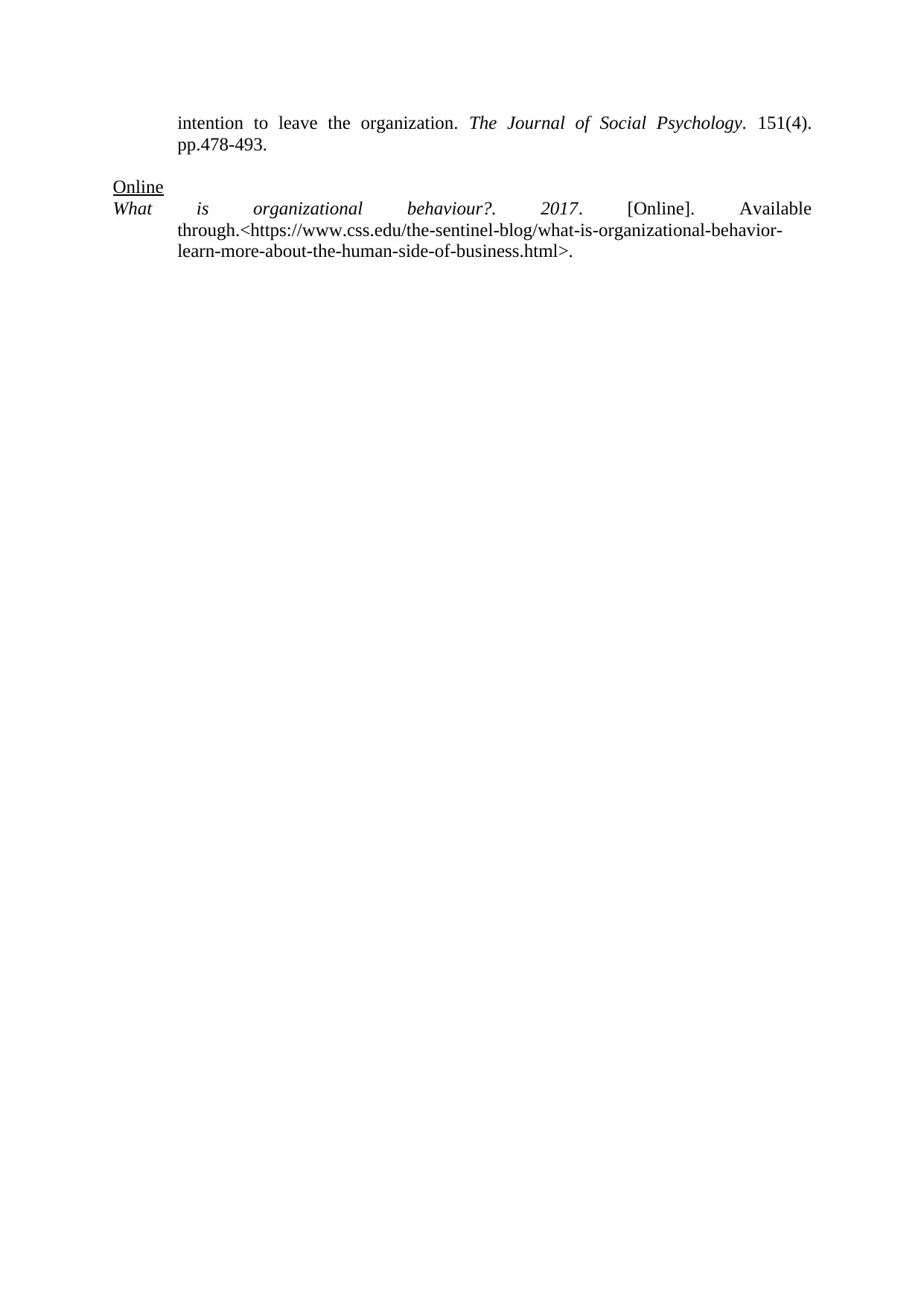
intention to leave the organization. The Journal of Social Psychology. 151(4).
pp.478-493.
Online
What is organizational behaviour?. 2017. [Online]. Available
through.<https://www.css.edu/the-sentinel-blog/what-is-organizational-behavior-
learn-more-about-the-human-side-of-business.html>.
pp.478-493.
Online
What is organizational behaviour?. 2017. [Online]. Available
through.<https://www.css.edu/the-sentinel-blog/what-is-organizational-behavior-
learn-more-about-the-human-side-of-business.html>.
1 out of 15
Related Documents
Your All-in-One AI-Powered Toolkit for Academic Success.
+13062052269
info@desklib.com
Available 24*7 on WhatsApp / Email
![[object Object]](/_next/static/media/star-bottom.7253800d.svg)
Unlock your academic potential
© 2024 | Zucol Services PVT LTD | All rights reserved.





